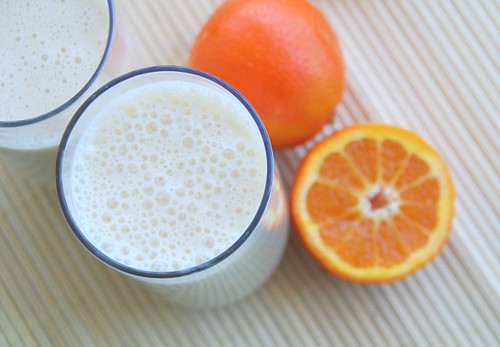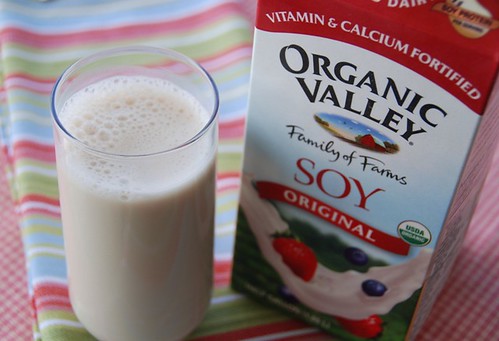Creamsicle Power Smoothie
Today's post is guest written by Exercise Blogga (Food Blogga's alter ego).
Good Morning! Did everybody have breakfast? Good.
Did everybody exercise? What? Why not? Don't you know:
- Exercise reduces your risk of cardiovascular disease, high blood pressure, Type 2 diabetes, and several cancers.
- Exercise helps you control your weight, improve your metabolism, and build muscle and bone strength to combat osteoporosis.
- Exercise alleviates stress, builds self-esteem, and helps you get a better night's sleep.
- Exercise will also make you look better in your bikini this summer. (Now have I got your attention?)
Weight bearing exercise refers to exercise in which your feet and legs are "bearing your weight," and your bones and muscles are working against gravity. Walking, jogging, and stair climbing are examples.
Resistance exercises refer to strength training such as Nautilus equipment or free weights (hand-held weights).
Of course, you should talk to your doctor before starting any exercise routine, especially if you have had bone fractures or have been diagnosed with osteoporosis.
For every positive reason to exercise, there are reasons not to, such as: I don't have the time, or I feel stupid going to a gym. Maybe I can help. I've been doing strength training and cardio 6 days a week at a gym for years now, and I love it. I didn't love it when I started, so here are my 7 personal tips for starting and maintaining a regular exercise program:
- Be realistic. You will fail if you set yourself up to fail. But you will succeed if you set achievable goals. Start slowly--perhaps 2-3 days a week.
- Be patient. Did you know it takes your brain about 3 weeks to develop a habit? That means if you can stick with an exercise plan for 3 weeks, the chances are pretty good you'll keep exercising.
- Select days and times you want to exercise and schedule it in just like you would any other important appointment.
- Resist giving in to the "I don't feel like exercising" feeling. Ask yourself, "What am I going to do instead?" If it isn't much better, then go work out, even it's just for 20 or 30 minutes.
- Do exercises you enjoy. If you hate running, then walk briskly. You'll be more likely to stick with it if you like it. Remember, however, that it's important to challenge your body with different exercises, so maybe 1 or 2 times a week, try something new like a spinning class or a few laps in the pool.
- Begin weight training with Nautilus equipment or free weights. Resistance training builds bone and muscle mass, makes you stronger, improves your metabolism, and helps burn fat even when you're not exercising.
- If you're a gym newbie, then consider hiring a trainer for 4 or 5 sessions to teach you the basics (many gyms offer this free with membership).
- Subscribe to a fitness magazine such as Women's Health or Muscle and Fitness, Hers.
- Believe me when I tell you, ladies, "You won't bulk up." You'd have to work out several hours every day, eat nothing but egg whites and plain fish, and have enough testosterone to grow a beard. I swear.
Eating well is an important part of any exercise plan, and protein drinks are a simple, healthy pre- or post-workout meal. Most protein smoothies are made with whey protein because it stimulates muscle growth and aids in recovery. If you're lactose-intolerant (like I am), then whey isn't an option since it's a by-proudct of cow's milk cheese.
I use soy protein instead; it contains all nine essential amino acids making it a “complete protein," and helps meet your body’s needs in regards to building and maintaining muscle. Also, soy protein contains isoflavones which aid the body’s absorption of calcium into bones and has been linked to a decrease in osteoporosis.
Soy protein is easily digestible and virtually tasteless (though flavored varieties are available). It is widely available at health food stores and organic markets such as Whole Foods. So why not give it a try?
Want to send a calcium-rich entry to Beautiful Bones, my osteoporosis food event? Then click here for full details. And many thanks to all of you who have already submitted recipes. There is an inspiring array of calcium-rich breakfasts, main meals, and desserts, and every one is fabulous!
This refreshing smoothie will cool you right off after a hard work out.
Creamsicle Power Smoothie
Makes 1 serving
Print recipe only here.
1/2 cup soy milk** or skim milk
1/2 cup calcium-fortified orange juice
1/2 large banana
3 tablespoons soy protein powder
1 teaspoon sugar, Stevia, or Splenda
1/4 cup ice cubes
Place all ingredients in a blender and blend on high for 10-15 seconds until frothy. If you like it thinner, then simply add a little bit of water.
**I prefer both Organic Valley brand soy milk and Silk brand Soy Milk. Both are high in calcium and protein and taste great.
You might also like these dishes for a post-workout meal. They contain lean protein and complex carbs, which replenish your muscles after a hard workout.
 Breakfast Egg Sandwich with Avocado and Chipotle-Mayo
Breakfast Egg Sandwich with Avocado and Chipotle-Mayo Heuvos Rancheros with Salsa Verde
Heuvos Rancheros with Salsa Verde Swordfish with Pineapple-Mango Salsa
Swordfish with Pineapple-Mango Salsa Save This Page on Del.icio.us
Save This Page on Del.icio.us

